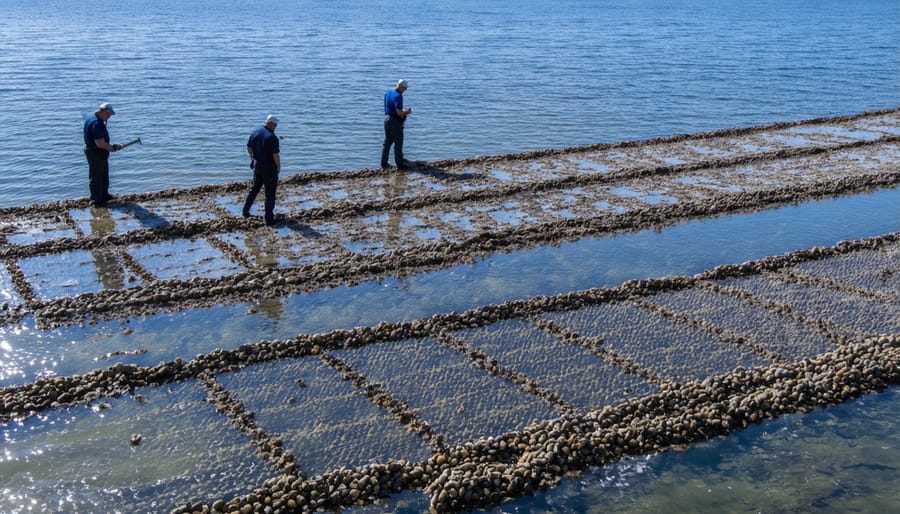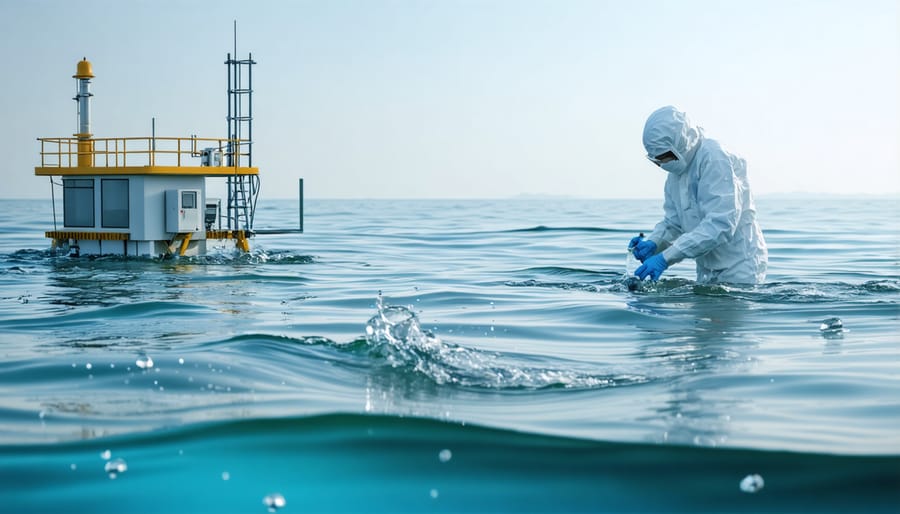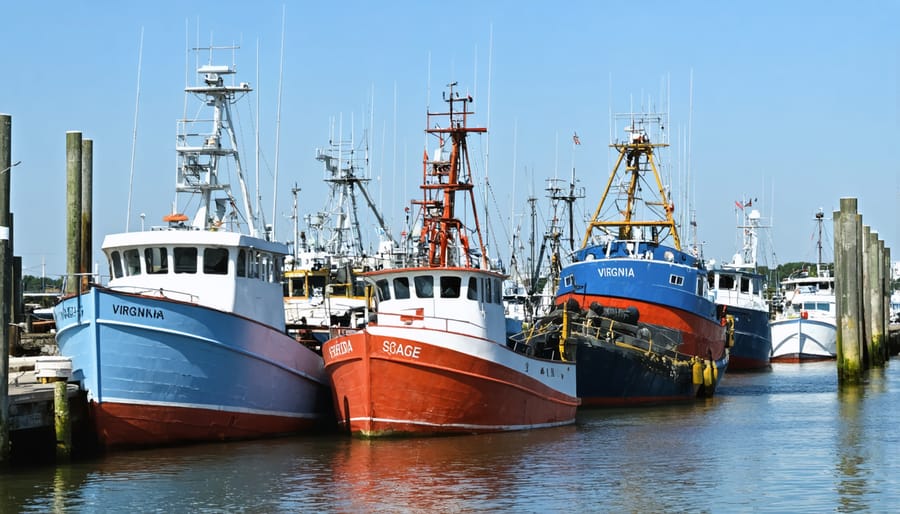
The Virginia Marine Resources Commission (VMRC) stands as a vital guardian of the Commonwealth’s aquatic ecosystems, safeguarding over 120,000 acres of state-owned submerged lands and 5,000 miles of tidal shoreline. As a pioneering force in marine conservation since 1875, the VMRC’s work deeply influences coastal community identity while ensuring sustainable fisheries management and habitat protection. Through science-based regulations, innovative conservation programs, and collaborative partnerships with stakeholders, the Commission maintains the delicate balance between commercial fishing interests, recreational activities, and environmental preservation. Their comprehensive approach encompasses everything from oyster reef restoration to blue crab population management, making them instrumental in preserving Virginia’s rich maritime heritage and securing its marine resources for future generations. For both commercial watermen and recreational enthusiasts, the VMRC serves as the primary authority on sustainable marine resource utilization, ensuring that Virginia’s waters remain productive, healthy, and accessible for all who depend on them.
Core Functions and Authority
Regulatory Powers
The Virginia Marine Resources Commission (VMRC) exercises broad regulatory authority over the Commonwealth’s marine and aquatic resources. The Commission issues licenses for commercial and recreational fishing, oversees habitat permits, and enforces regulations to protect marine ecosystems. Through its Law Enforcement Division, VMRC officers patrol Virginia’s tidal waters, ensuring compliance with fishing regulations, investigating violations, and conducting safety inspections of vessels.
The Commission has the power to establish fishing seasons, set catch limits, and determine gear restrictions for both recreational and commercial fishing activities. It also regulates the harvesting of shellfish, particularly oysters and clams, through a detailed permitting system. VMRC manages submerged lands and oversees activities affecting tidal wetlands, requiring permits for construction projects, dredging operations, and shoreline modifications.
Additionally, the Commission collaborates with federal agencies and neighboring states to develop comprehensive management strategies for shared waterways. This includes participating in interstate fishery management plans and implementing conservation measures to protect endangered species. The Commission regularly reviews and updates its regulations based on scientific data and public input, ensuring sustainable use of Virginia’s marine resources for future generations.

Conservation Programs
The VA Marine Resources Commission operates several vital conservation programs aimed at protecting Virginia’s marine ecosystems and species. Their flagship initiatives include the Oyster Replenishment Program, which focuses on restoring native oyster populations through reef construction and shell recycling efforts. The Commission also maintains an extensive Blue Crab Management Program to ensure sustainable harvesting practices and population monitoring.
A significant focus is placed on habitat restoration, with dedicated efforts toward preserving submerged aquatic vegetation and wetlands. The Commission’s marine debris management program engages local communities in coastline cleanup efforts while educating the public about the importance of reducing plastic pollution.
The Living Shorelines Initiative promotes natural solutions to coastal erosion while creating essential wildlife habitats. Through partnerships with research institutions and environmental organizations, the Commission also supports scientific studies of endangered species, including the Atlantic sturgeon and sea turtles. These programs rely heavily on community involvement, offering volunteers opportunities to participate in conservation activities while learning about marine ecosystem protection.
Protecting Public Health Through Marine Management
Water Quality Monitoring
The Virginia Marine Resources Commission maintains robust water quality monitoring programs that safeguard both public health and marine ecosystems. Through a network of testing stations across Virginia’s coastal waters, the commission regularly analyzes water samples for various contaminants, bacteria levels, and other potential hazards that could affect both recreational activities and seafood safety.
Working closely with certified laboratories, VMRC staff collect and process thousands of water samples annually, tracking parameters such as dissolved oxygen, temperature, salinity, and bacterial counts. This data helps assess the environmental impact on coastal communities and ensures safe conditions for swimming, fishing, and shellfish harvesting.
The commission’s monitoring efforts are particularly crucial for Virginia’s shellfish industry, where water quality directly impacts harvesting permissions. When water quality concerns arise, the commission can quickly implement temporary harvest closures to protect public health. These decisions are based on scientific data and strict federal guidelines.
Volunteer water quality monitoring programs complement these efforts, engaging citizen scientists in data collection and environmental stewardship. Through these initiatives, local community members learn about water quality issues while contributing valuable data to the commission’s monitoring efforts. This collaborative approach has proven effective in identifying potential problems early and maintaining the health of Virginia’s coastal waters.
The commission also maintains an online database where the public can access real-time water quality information, helping residents make informed decisions about water-based activities while promoting transparency in environmental monitoring efforts.

Seafood Safety Standards
The VMRC maintains rigorous seafood safety standards to protect public health while supporting the state’s vibrant commercial fishing industry. Through comprehensive monitoring programs, the commission regularly tests water quality in harvesting areas and inspects processing facilities to ensure compliance with federal and state regulations.
A key focus area is shellfish sanitation, where trained inspectors conduct year-round sampling of oyster and clam beds. These tests check for harmful bacteria, biotoxins, and other potential contaminants that could affect both marine life and human consumers. When conditions don’t meet safety thresholds, the commission can quickly close harvesting areas until water quality improves.
Commercial fishing vessels and processing facilities must adhere to strict handling and storage requirements. Regular inspections ensure proper temperature control, sanitary conditions, and accurate documentation of catch origins. The commission also provides training and certification programs for seafood handlers to maintain high safety standards throughout the supply chain.
Working alongside the Virginia Department of Health, the VMRC helps track and respond to potential health risks, including harmful algal blooms and bacterial outbreaks. This collaborative approach has helped Virginia maintain its reputation as a trusted source of quality seafood while protecting both industry workers and consumers.
The commission’s efforts extend to public education, offering resources about safe seafood handling and consumption guidelines, particularly for sensitive populations. This comprehensive approach to seafood safety has helped sustain Virginia’s marine economy while safeguarding public health.
Economic Impact on Coastal Communities

Sustainable Fishing Industry
The VMRC plays a vital role in maintaining sustainable fishing practices through its comprehensive quota and licensing management system. The commission carefully monitors commercial fishing activities, establishing catch limits based on scientific data and population assessments of various marine species in Virginia’s waters.
Through a structured licensing program, the VMRC ensures that commercial fishing operations meet strict environmental and safety standards. Each year, the commission reviews and adjusts quotas for key species like striped bass, blue crabs, and menhaden, considering factors such as population dynamics, ecosystem health, and economic impacts on fishing communities.
The commission’s data-driven approach includes regular stock assessments, which help determine sustainable harvest levels. This information is used to issue appropriate numbers of commercial licenses and set seasonal restrictions when necessary. The VMRC also works closely with federal agencies and neighboring states to coordinate management efforts across shared waters.
To support compliance, the commission provides educational resources and technical assistance to commercial fishermen, helping them understand and implement sustainable fishing practices. This collaborative approach has helped maintain the delicate balance between economic viability and environmental conservation in Virginia’s marine waters.
Tourism and Recreation
The Virginia Marine Resources Commission plays a vital role in supporting the Commonwealth’s thriving coastal tourism industry while ensuring sustainable resource management. Through careful oversight of beach access, recreational fishing, and coastal cultural preservation, the Commission helps maintain Virginia’s coastal areas as premier destinations for visitors and residents alike.
The Commission issues recreational fishing licenses, monitors water quality at public beaches, and maintains artificial reefs that enhance both fishing opportunities and marine habitat. These efforts not only protect marine ecosystems but also support the region’s tourism-based economy, which generates millions in revenue annually.
Working closely with local communities, the Commission helps develop sustainable tourism practices that balance recreational access with environmental protection. This includes managing public boat ramps, supporting educational programs about marine conservation, and coordinating with local businesses to promote responsible eco-tourism activities.
Through these initiatives, the Commission ensures that Virginia’s coastal resources remain both economically valuable and environmentally sustainable for future generations to enjoy.
Community Engagement and Education
The VA Marine Resources Commission actively engages with coastal communities through various educational programs and outreach initiatives designed to foster environmental stewardship. Through partnerships with local schools, the Commission offers marine science education programs that introduce students to the importance of sustainable fishing practices and marine ecosystem conservation.
A cornerstone of community engagement is the Marine Resource Education Program (MREP), which provides hands-on learning experiences for both children and adults. Participants can join guided beach walks, attend workshops on marine biology, and learn about local species identification. These programs often feature guest appearances by marine biologists who share their experiences and knowledge about Virginia’s diverse marine life.
The Commission also maintains a robust volunteer network through its Citizen Science Program. Volunteers assist in various projects, including water quality monitoring, shoreline cleanup initiatives, and fish population surveys. This program not only provides valuable data for research but also helps create a sense of environmental responsibility among participants.
Regular public forums and town hall meetings allow community members to voice their concerns and contribute to policy discussions. The Commission’s website features an interactive calendar of events, educational resources, and opportunities for public comment on proposed regulations.
For those interested in deeper involvement, the Commission offers training programs for recreational fishing guides and environmental educators. These programs help create a network of informed citizens who can share their knowledge with others and promote sustainable marine resource management.
Through social media platforms and monthly newsletters, the Commission keeps the public updated on conservation efforts, success stories, and upcoming events, ensuring continuous engagement with Virginia’s coastal communities.
The Virginia Marine Resources Commission stands as a vital guardian of our coastal waters, marine life, and maritime communities. Through its comprehensive management of fisheries, habitat protection initiatives, and regulatory oversight, VMRC ensures the sustainable use of marine resources while preserving them for future generations. The commission’s work extends beyond mere conservation, creating a balanced ecosystem where both wildlife and human activities can thrive harmoniously.
By engaging with local communities, supporting scientific research, and enforcing regulations that protect marine environments, VMRC has demonstrated that effective resource management requires both expertise and collaboration. The commission’s success stories, from oyster population restoration to sustainable fishing practices, showcase how dedicated conservation efforts can yield positive results for both the environment and the economy.
As we face increasing environmental challenges, VMRC’s role becomes even more crucial. Their adaptive management strategies and commitment to public education ensure that Virginia’s marine resources remain resilient and productive. Through continued support and participation from the community, VMRC will continue to safeguard our valuable marine ecosystems while promoting sustainable economic opportunities for coastal communities.
jessica
Ava Singh is an environmental writer and marine sustainability advocate with a deep commitment to protecting the world's oceans and coastal communities. With a background in environmental policy and a passion for storytelling, Ava brings complex topics to life through clear, engaging content that educates and empowers readers. At the Marine Biodiversity & Sustainability Learning Center, Ava focuses on sharing impactful stories about community engagement, policy innovations, and conservation strategies. Her writing bridges the gap between science and the public, encouraging people to take part in preserving marine biodiversity. When she’s not writing, Ava collaborates with local initiatives to promote eco-conscious living and sustainable development, ensuring her work makes a difference both on the page and in the real world.
